Part 1: About us
Our purpose
The Controller and Auditor-General (the Auditor-General) carries out audits, performance audits, and inquiries, and reports to Parliament and the public to improve the performance of, and the public's trust in, the public sector.
The Auditor-General's role
The Auditor-General is an Officer of Parliament who carries out her role independent of executive government and Parliament, but is accountable to Parliament for the public resources she uses to do the job.
By law, the Auditor-General is the auditor of all public entities in New Zealand – about 4000 entities, such as government departments, local authorities, Crown entities, schools, and State-owned enterprises.
All public entities are accountable for their use of public resources and powers. The Auditor-General's role is to give Parliament and the public independent assurance about how public entities are operating and accounting for their performance.
The role also includes auditing local authorities, which are accountable to the public for the activities they fund through locally raised revenue. As well as annual audits, the Auditor-General audits local authorities' long-term plans, which are prepared every three years.
The Auditor-General recommends actions to help improve public sector performance and how performance information is reported to Parliament and the public.
The Public Audit Act 2001 sets out the mandate and responsibilities of the Auditor-General. The Auditor-General's legislative mandate is confined to public entities, for which the Auditor-General:
- must carry out the annual audit requirements of the Public Audit Act 2001 and other statutes (such as the Public Finance Act 1989 and Local Government Act 2002, which set out accountability responsibilities of public entities);
- may carry out other services of a kind that it is reasonable and appropriate for an auditor to perform; and
- may carry out performance audits and inquiries.
The organisation
The work of the Auditor-General is carried out by about 350 staff in two business units – the Office of the Auditor-General (OAG) and Audit New Zealand, supported by a shared team of corporate services staff – and by auditors contracted from about 60 private sector accounting firms.
The OAG carries out strategic planning, sets policy and standards, appoints auditors and oversees their performance, carries out performance audits, provides reports and advice to Parliament, and carries out inquiries and other reporting.
Audit New Zealand is the larger of the two business units. It carries out annual audits allocated by the Auditor-General and operates from seven locations around the country. It also provides other assurance services to public entities within the Auditor-General's mandate and in keeping with the Auditor-General's auditing standard on the independence of auditors.
Figure 1 shows how all these parts fit together in our operating model.
Figure 1
Our operating model
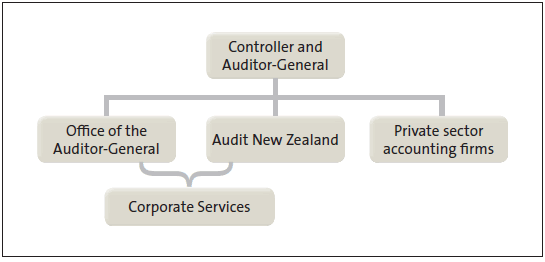
Our vision and operating intentions
Our vision is to improve the performance of, and the public's trust in, the public sector. In the medium term, our strategy is to generate greater insight and value from our work by improving our understanding of the public entities we audit, using the full range of our resources, customising our reporting, and improving the overall capability and engagement of our staff.
Strategic framework
Our strategy for 2013-17 has not altered the three outcomes we aim for, namely:
- a trusted public sector;
- an appropriately responsible public sector; and
- a high-performing public sector.
The high-level impacts we seek are that:
- our annual audits, inquiries, and performance audits encourage public entities to respond effectively to our recommendations for improvement; and
- Parliament, local government, and other stakeholders are supported and get value from our advice.
Our outcomes framework diagram in Figure 2 summarises the outcomes we are seeking, the impacts we aim to make, and the outputs we deliver. It also shows that our work is underpinned by our organisational health and capability, which is achieved through a well-run OAG and Audit New Zealand.
We provide details about the standards we use to measure our achievements and the results of those measures for our outcomes, impacts, and outputs in previous years in the pages after Figure 2.
Figure 2
Outcomes framework


Measures and standards for achieving our outcomes, and previous performance
| Trusted public sector |
|
Measure: New Zealand is ranked in or above the 90th percentile of the Worldwide Governance Indicators. Comment: The World Bank's Worldwide Governance Indicators1 capture six key dimensions of governance and measure the quality of governance in over 200 countries. We use New Zealand's ranking as an indicator of trust in the public sector. The latest results show New Zealand maintained its ranking above the 90th percentile. Results are shown in calendar years and not yet available for 2012. |
Figure 3
New Zealand's ranking in the Worldwide Governance Indicators, 2008 to 2011
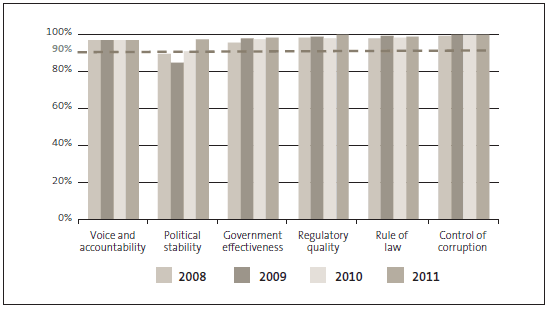
|
Measure: The State Services Commission's Kiwis Count Survey2 shows improved (or at least maintained) rates of public trust with:
Comment: The Kiwis Count Survey, which is independently administered by the State Services Commission, tracks improvement in public services. A redesign of the Kiwis Count Survey in 2012 changed the frequency of data collection and some of the survey questions. This year, we have revised our measure for this outcome in keeping with the survey methodology changes. Data collection for this revised measure is reported on a quarterly basis. The variation in percentage points for both questions over this period is not statistically significant. |
Figure 4
Kiwis Count Survey results in June 2012 and September 2012 quarters: Perceptions of trust in the public sector and trust with most recent service experience
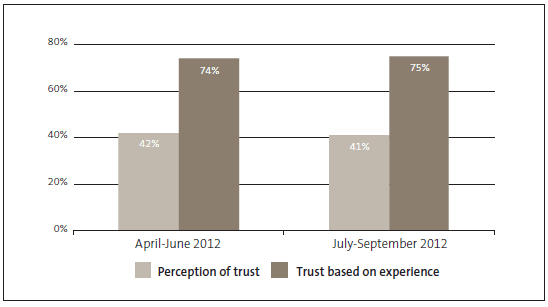
|
Measure: New Zealand's score on the Transparency International Corruption Perceptions Index is improved (or at least maintained). Comment: One of the measures available to track perceptions of public trust in government is the Transparency International Corruption Perceptions Index.3 The index is an aggregate indicator that annually ranks over 180 countries by their perceived levels of corruption in the public and political sectors. In 2012, New Zealand maintained its ranking, and is currently ranked first equal with Denmark and Finland. |
Figure 5
New Zealand's score on the Transparency International Corruption Perceptions Index, 2009 to 2012
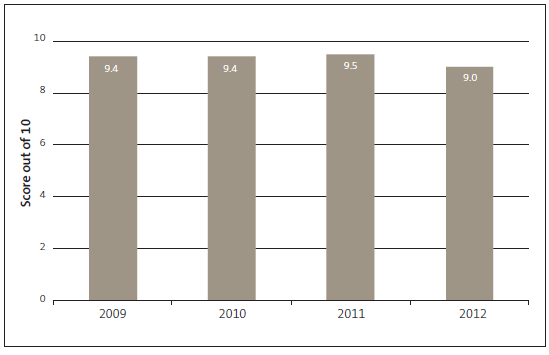
|
Measure: Public entities' financial reports fairly reflect their actual performance and are publicly available on time. Comment: Responsible public entities provide the public with audited financial reports that are on time and fairly reflect their performance. Audits that are completed on time provide an indicator that public entities are well managed and meeting their reporting responsibilities. An unmodified audit opinion is an indicator that public entities are reporting appropriately and in accordance with standards. We track the percentage of audits completed on time and the percentage of unmodified audit opinions as a measure of appropriately responsible public sector behaviour. Results: Results for the previous four years and the target for 2013/14 to 2015/16 are shown in Figure 6. |
Figure 6
Percentage of unmodified audit opinions and audits completed on time

|
Measure: The State Services Commission's Integrity and Conduct Survey4 shows improved (or at least maintained) rates of State servants who report that State service agencies promote their standards of integrity and conduct. Comment: The Integrity and Conduct Survey measures levels of trustworthy behaviour observed by State servants within their agencies. We use results from this survey as indicators of appropriately responsible public sector behaviour. This survey is held every three years, and 2013 results are not yet available. |
Figure 7
Integrity and Conduct Survey results in 2007 and 2010: State service agencies that promote their standards of integrity and conduct
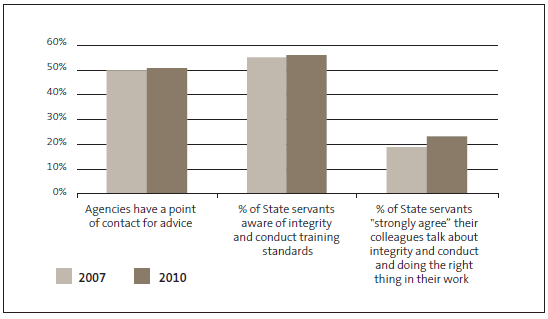
| Measure: The State Services Commission's Integrity and Conduct Survey shows improved (or at least maintained) rates of State servants who reported that, where they observed misconduct breaches in the past year, they reported it. |
Figure 8
Integrity and Conduct Survey results in 2007 and 2010: State servants' observation and reporting of misconduct
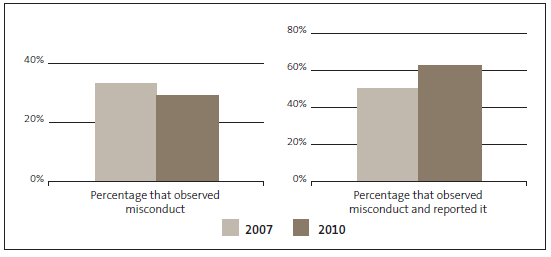
| High-performing public sector |
| Measure: The State Services Commission's Kiwis Count Survey shows improved (or at least maintained) rates of service quality for all public services. Comment: This year we have revised our measure for a high-performing public sector to better reflect the Kiwis Count Survey methodology changes. The data for this measure is reported on a six-month rolling average and, while a two-point increase is a positive sign, the movement is not large enough to be statistically significant. |
Figure 9
Kiwis Count Survey results for January to June 2012 and April to September 2012: Service quality score for all public services
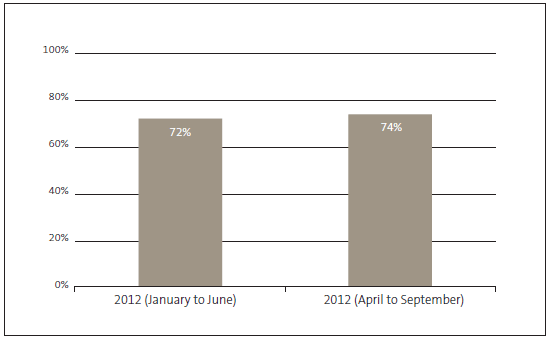
Managing in a challenging operating environment
The Auditor-General's overview highlights the fundamental changes happening throughout the world and the New Zealand public sector. These changes continue to influence our environment and will require us to change aspects of how we work as an Office.
Our intention is to use the public resources entrusted in us even more effectively and efficiently. Our response includes a theme-based audit work programme that builds on our previous year's work. The programme will focus on public sector service delivery, and will examine how well the public sector is responding to the need to deliver improved services for less through changing service delivery structures, models, and methods.
Our work will include better use and sharing of our knowledge about the public sector, examining elements of future needs and preparedness through our annual audits, and a study of asset management practice in local government. Our performance audits will examine specific questions about service delivery, such as delivering services in a digital environment and service delivery through third parties. We will continue to respond to the range of structural governance and legislative changes in the public sector, and prepare ourselves for auditing in an environment of new accounting standards. We anticipate implementation of phase one of our new system to improve the sharing of information and insights collected by our Office.
We are confident our response will enable us to continue to be valued for our audit work and contribute to improving the performance of, and the public's trust in, the public sector.
Strategic risks and risk management
The Auditor-General faces four ongoing strategic risks:
1. loss of independence;
2. audit failure;
3. loss of capability; and
4. loss of reputation.
These risks are primarily managed through processes that support the work we do. Details on how we manage these risks are provided in the Appendix.
The Office will continue its focus on managing risks, particularly strategic risks. The leadership team discusses risk management quarterly, including assessing any environmental or internal changes that may affect the Office's position. The Office's Audit and Risk Committee meets four times a year, and provides additional insight and advice to the Office for identifying and managing risk.
1: See http://info.worldbank.org/governance/wgi/index.asp.
2: See http://www.ssc.govt.nz/kiwis-count.
3: See http://cpi.transparency.org/cpi2012.
4: See http://www.ssc.govt.nz/2010-survey-report.
page top